Mento's May Madness Melange: #5 - Pointin' Clique
By Mento 3 Comments
Of all the unplayed stuff I have sitting in my Steam library, the clear majority of them are Indie graphic adventure games that I've gone out of my way to track down. We've had a recent resurgence of these types of narrative- and puzzle-driven games, because it would appear that there are plenty of Indie devs out there who grew up playing Day of the Tentacle or Gabriel Knight or King's Quest and are rather indignant that this genre was left to rot after the FMV generation lobotomized it, with the wider PC gaming industry subsequently then mercifully smothering it, smashing a window with a ceramic console and running for the hills to pursue extremely dry strategy and simulation games instead.
Anyway, I have more than a few of these things, as someone who is as equally attached to the genre as the many devs who are even now creating new ones for a modern audience. I've been meaning to devise some sort of recurring feature where I cover the ones I have in depth on a weekly/monthly basis, but the issue with that is that discussing them in too much detail would mean giving away the puzzles or major elements of the story and that would only serve to diminish their appeal for anyone wanting to try them themselves.
Instead, here's a short and spoiler-free look at a trio of point and click adventure games that I've been curious about for a while, and May Madness seemed as opportune a time as any to give them a gander.
The Book of Unwritten Tales
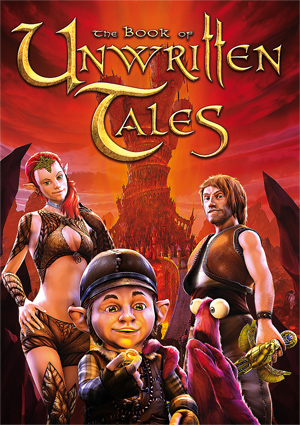
The game: King Art Games' The Book of Unwritten Tales, a fantasy parody graphic adventure game.
The source: The Humble Weekly Sale: The Adventure Company and Friends
The pre-amble: The Book of Unwritten Tales is a classic graphic adventure game, complete with NPCs with long dialogue chains, icons that tell you how to interact with the hotspots in the environment, inventory items that are used to solve puzzles and a lot of really, really nice looking screens to stroll though while you try using every item on everything in the vicinity. (Just so I won't have to copy/paste this paragraph, this also applies to the other two games today.)
The Book of Unwritten Tales also has a self-aware satirical streak a mile wide, starting with its contradictory name and then moving onto almost every other puzzle, event and character in the game. It's not so heavy to be too cloying or precious, however, and the game manages to be pretty funny when it's not leaning too hard on reference humor. The game also frequently switches protagonists from a naive little gnome with great aspirations of heroic wizardry, and a considerably more worldly elf princess who gets caught up along the way.
The playthrough: So far I'm really enjoying this game. It's sometimes hard to describe how a graphic adventure might be better or worse than any other, because they all use a similar blueprint and the real differences come down to how abstruse the puzzles are and how well the game's script is written by its designers and performed by the voice artists. TBoUT looks incredible, especially given how relatively old it is (five years might not be the eternity in technological game advancement time it once was, but it's still smack dab in the middle of the last generation of consoles). The 3D models for the characters might seem a bit dated (I still love the attention in Wilbur, the gnome character, and his facial animations), but the environments are as striking now as they presumably were back then.
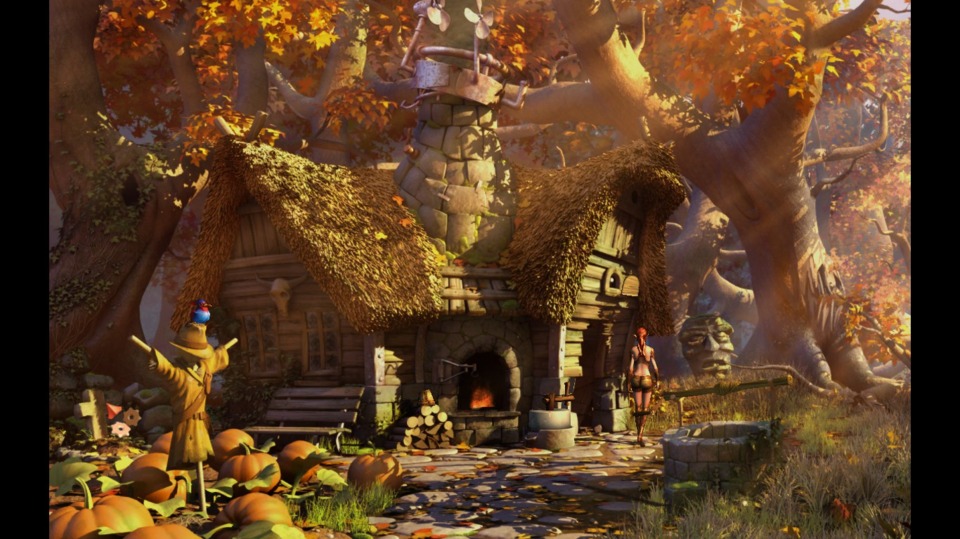
But what really makes Book of Unwritten Tales shine, and how it makes itself so accessible to the many fans that have long since abandoned this genre for demanding too much illogical mental gymnastics over the years, is that certain hotspots in the environment will simply cease to exist once it's established that they have no further use. A character might get a few remarks out of an immaterial piece of background art, and then the contextual "examine" symbol will stop showing up for it. Likewise, once an inventory item is surplus to requirement, it's summarily abandoned. This greatly diminishes the amount of wandering around and vainly performing trial and error tests with everything currently within arm's reach. If a hotspot is still active or an item still sitting around, it's more than likely it's because you still need it for something. Many other conveniences such as clicking to skip walking animations to new areas, a single icon that changes depending on the context rather than a list of commands and maps that let you warp around when there's multiple locations to visit are all present and accounted for, and very welcome.
For full disclosure I'm partway through Chapter 3 and quite a few hours into the game, and there's been a lot of instances of being given a list of items to search for in order to achieve a goal and move onto the next part of the game: a menu of ingredients for a potion, for example, or a list of "military equipment" that Wilbur's grandfather asks him to procure before he'll allow him to head off on an adventure. It's fine to an extent, as this is supposed to be a satirical take on this genre as much as it is riffing on fantasy universes and hokey RPG clichés in general, but I'm sure they could go to a little more effort than returning to the same set-up over and over. The writing's also of an overall high quality, but there's still a few unnecessary reference gags of the type where "saying a thing that was a quote from another thing" is the whole joke. It also skews a bit too close to stealing from a few of their inspirations outright - a group of NPCs playing an "exciting" accounting and bureaucracy role-playing game to escape their "dull" fantasy world was lifted right out of Simon the Sorcerer II, for one, even if they switched the format from table-top to MMOs in order to make jokes about "buggy servers" (which is to say, you put literal bugs on the monkey servant running the MMO). Given how big the Simon the Sorcerer games were in Germany, and how a German studio went on to create the last two games in that series after the original developers wisely abandoned it after the abjectly terrible Simon the Sorcerer 3D, the strong influences don't surprise me.
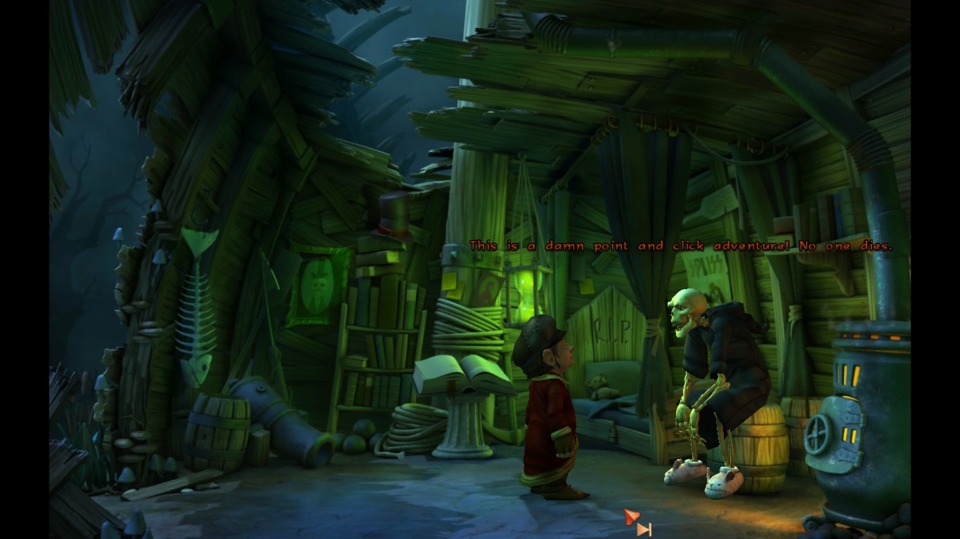
So it's a bit lazy in parts, but these are minor gripes and there's certainly enough charm to keep me hooked for the time being. Now that I have both the protagonists in the same place and can switch between them, I expect some more interesting puzzles will be coming my way.
The verdict: Yep, I'm going to stick with this one. I've gotten pretty far already and wouldn't mind seeing how it concludes.
Primordia
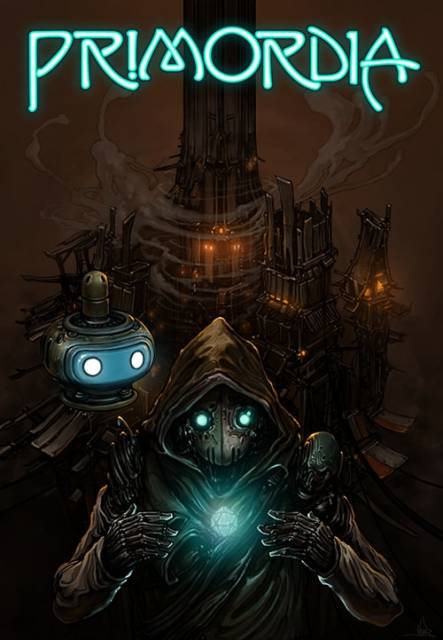
The game: Wadjet Eye Games's Primordia, a bleak post-apocalyptic sci-fi adventure game. Wadjet Eye also created Resonance and Gemini Rue.
The source: Double-dipped with this one, first with the Indie Royale Hammerhead Bundle and then with Groupees' Be Mine 8. Both bundles happened almost concurrently as well.
The pre-amble: Primordia is an adventure game set in a post-apocalyptic world where only robots remain and mankind has long since passed into mythology as benevolent creators. An android named Horatio and his sarcastic floating companion Crispin are attempting to fix a colossal machine they recovered from the wastelands, but are attacked by a monolithic robot which then steals their priceless power supply crystal. So begins a series of quests to find another power supply for their enormous machine, known only to them as "Unniic".
As for the presentation, Wadjet Eye continues to focus on creating games that look like they were made in the 90s. This isn't a pejorative, but rather a deliberate decision on their part to call back to that era of 2D sprite-based adventure games when the genre was on top. Like Gemini Rue and Resonance, their previous two games, Primordia is a classic point and click adventure game with a few tricks up its sleeve, but mostly relies on its clever puzzles and writing. Real "back to the genre's roots" kind of stuff.
The playthrough: I said bleak earlier, but Primordia can be just as goofy and satirical as The Book of Unwritten Tales. Your little robot buddy is always cracking wise (though he's useful for broad tips on what you ought to be doing next as well), "b'sod" is frequently used as an expletive, and the game's packed with knowing references to sci-fi pop culture. They're a little more incidental here at least, prompted by examining background details of minimal importance to the story.
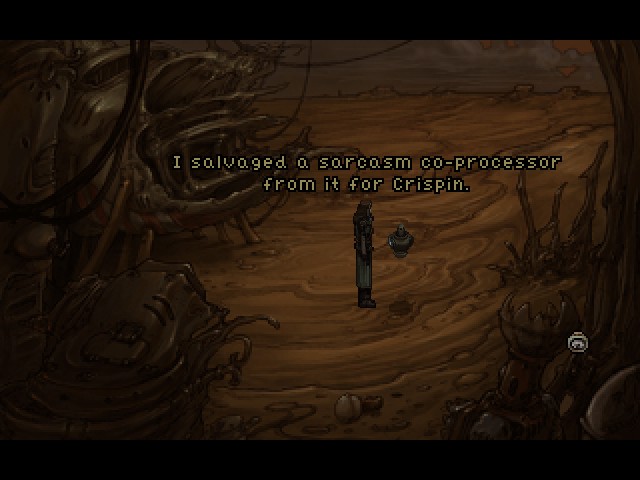
It's fairly widely regarded that the period between when 2D adventure games were given full voice acting and when they went completely FMV is the "golden era" of the genre, whether it's Sam & Max Hit the Road or Full Throttle or Indiana Jones and the Fate of Atlantis, and Wadjet seems determined to carry on as if nothing happened in the intervening years between then and now. It's not a bad strategy, honestly, and helps bring in an audience who loved the adventure games of that period and have drifted away since. I can't fault them for shrinking the resolution to something "Windows 95"ish, because they still focus on filling their games with a lot of really good pixel art. Animation and sprite scaling is a little more rudimentary, but that just adds to its retro appeal.
I'm liking the setting a lot too. While Gemini Rue owed a few of its narrative elements from Blade Runner, Primordia seems to have been inspired strongly by Beneath a Steel Sky, Machinarium and possibly the movies AI: Artificial Intelligence and Metropolis for flavor (the capital city is simply called "Metropol"). Its homages are legion though, and Primordia does a fine job in not aping any one of its sources too closely, creating a familiar but distinct whole. As with the other Wadjet Eye games I've played, it may look like much but it's got it where it counts. Great, now I'm dropping sci-fi references everywhere too.
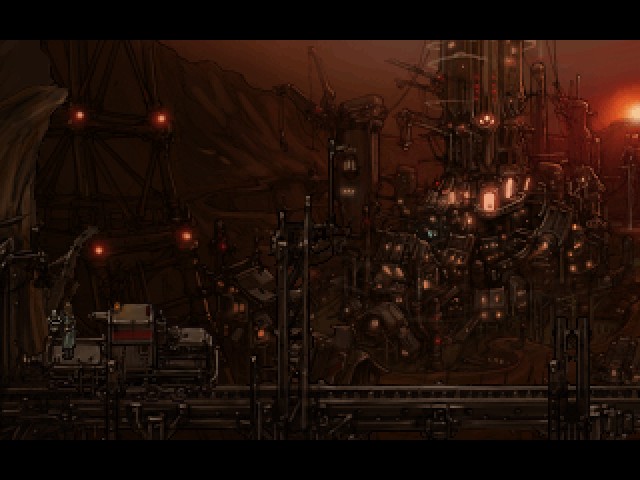
The verdict: I'm sticking with this too. I feel I'm at least halfway through the game, though there's little indication of progress. Man, I'm really leaving a lot of half-finished games in my "to do" pile for next month.
The Whispered World
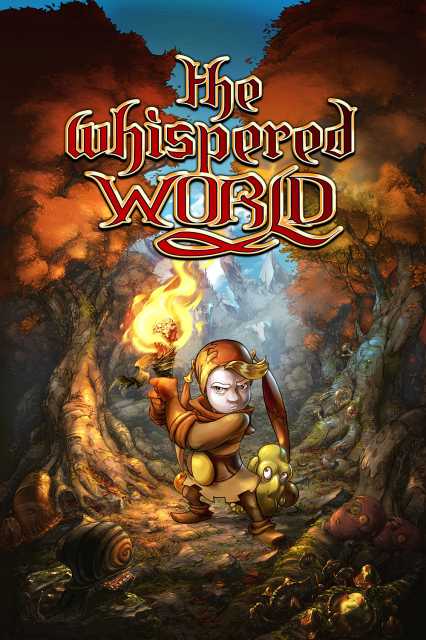
The game: Daedalic Entertainment's The Whispered World, another fantasy graphic adventure game. Daedalic also created the Deponia series and the Edna & Harvey series.
The source: Groupees' Be Mine 9 bundle.
The pre-amble: The Whispered World is set in the kingdom of Corona and its outskirts: a land that has seen better days, and is slowly falling apart as it reaches the natural end of its life. Sadwick, a lugubrious, diminutive clown whose heart is not really into pratfalls and slapstick, finds himself involved with an artifact known as the Whispering Stone and is pressed into finding some way to prevent the world's destruction, despite his prophetic nightmares divining the opposite. Though there's a few gags -- Daedalic's probably best known for their goofy humor, with games like Deponia -- the game and its characters can be quite moribund.
The playthrough: I figured this and Book of Unwritten Tales looked similar enough for a decent showdown. They really can't be much different tonally, though.
I talked about the modern conveniences offered in The Book of Unwritten Tales, and to a lesser extent Primordia since that's meant to be more of a throwback, but The Whispered World doesn't boast nearly as many of these features. Hotspots still remain even if they're inconsequential, and the player is still required to use a menu icon system similar to The Curse of Monkey Island's little dial of options rather than a simple singular contextual icon (though to be fair, there's only the three limited options of talk/eat, pick up/use and look). However, this game does have in its corner a function key that highlights every hotspot on the screen, which is an aid I've always appreciated. It completely eliminates that common complaint of "pixel hunting" for smaller items. As for the puzzles, they strike a balance between "what the heck am I supposed to be doing?" and "all right, here's a list of things to get, so just go find them", which I think is ideal for a game like this. You don't always want to be hunting down every item on a shopping list, after all, though it's also nice to have a stronger sense of purpose in one's clicking and pointing with transparent goals to chase after.
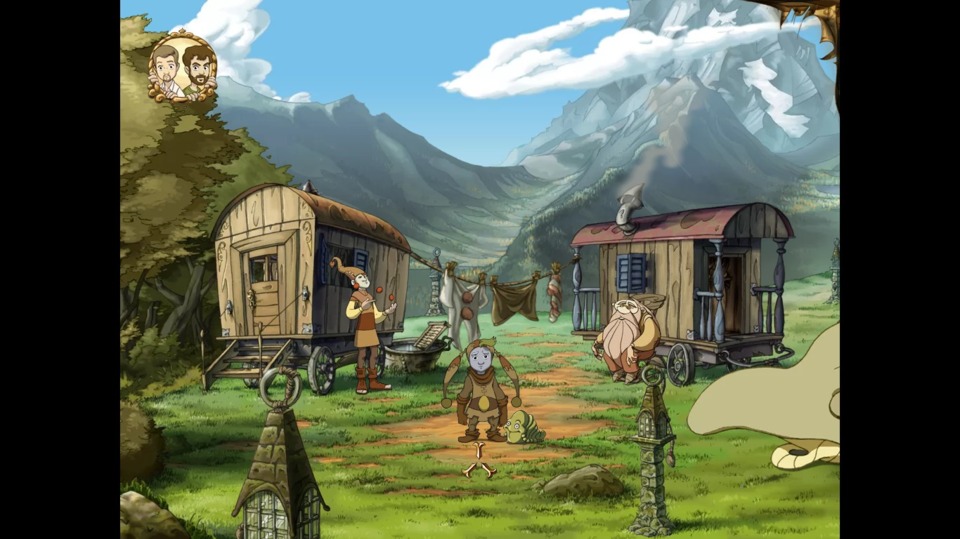
Graphically, the game uses some attractive static artwork backgrounds and some gloriously animated 2D sprites, with the overall animation style resembling a Rankin and Bass production. It can look a little cheap occasionally, but there's a lot of craft and attention to detail that makes The Whispered World seem more like an animated feature than a video game at times. The writing's spotty and the subtitles/documents are full of typos, but then the game was originally in German and it shows. It hasn't negatively impacted on my enjoyment or understanding of the game's story too much, however. The voice acting... well, I don't mind the other characters, but Sadwick's disconsolate yet squeaky voice (it sounds a bit like the voices Adam Sandler would adopt for his goofier characters) can be a pain to listen to for extended periods. Sadwick's a fine contrast to the legion of optimistic heroes of graphic adventure games old and new (though I'd say far more have at least some kind of cynical, sardonic streak to them), but listening to someone so emphatically miserable all the time can start to become contagious. It's why I got so enervated and depressed while playing The Stanley Parable: that negative, nihilistic tone can just weigh on you after so long like a ton of bricks. But hey, at least I don't have a sarcastic buddy in this one: Spot the caterpillar's just this big goofy ball of dumb whose versatile shape-shifts can be used for a few of the puzzles.
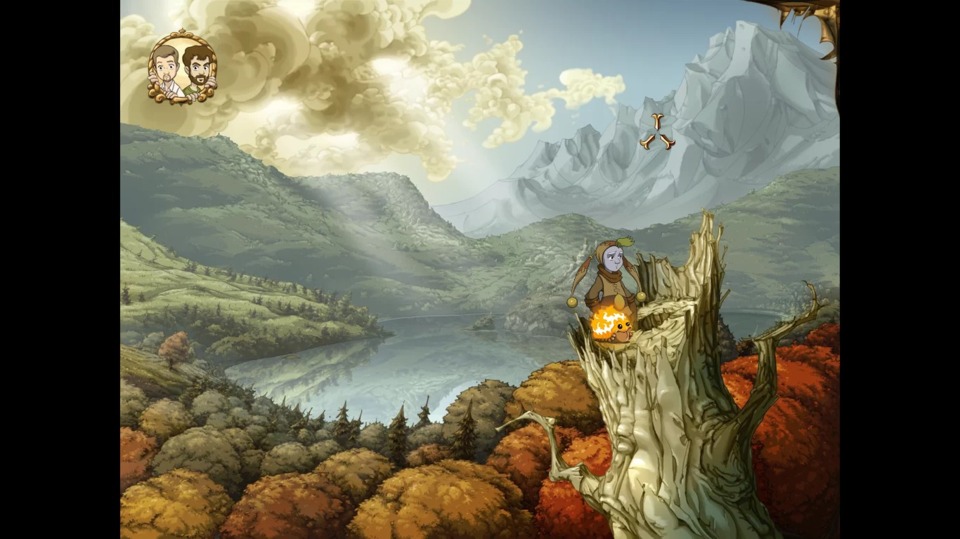
The verdict: It's my least favorite of the three games I've played for today's May Madness, but I may just stick with this one as well. As much as its tone seems to be disrupting my mood chemistry, I am curious about any game that sees out the end of its world. Some of the best moments of Majora's Mask and Super Paper Mario were when they were tackling the existential dread that is the end of everything.
The Moment of Truth
Hmm, this is a tough call. I'm going to give it to The Book of Unwritten Tales, because I was genuinely having trouble putting it away to play the two others for this feature, but I'll also award Primordia the consolation prize for "most interesting setting". I don't think The Whispering World is all too bad either, if a little lacking in comparison. Definitely no bad apples in the barrel this time around.
It sounds like we'll be getting sequels to The Book of Unwritten Tales and The Whispered World (so I guess the world doesn't end?) early next year too, so that's even more reason to get their precursors out of the way with.
